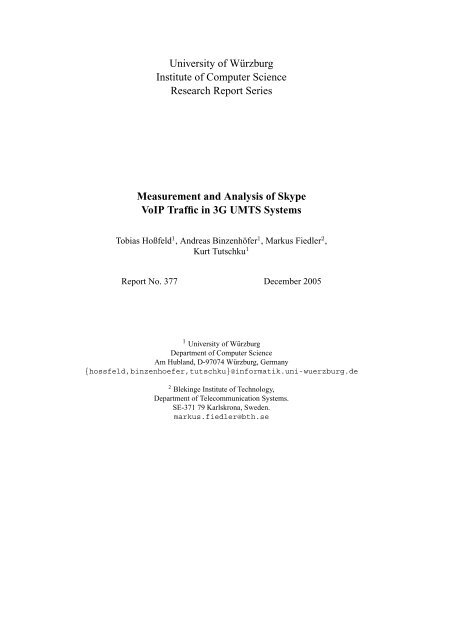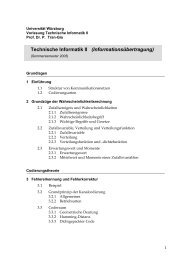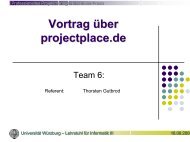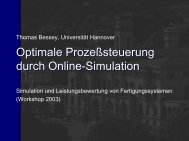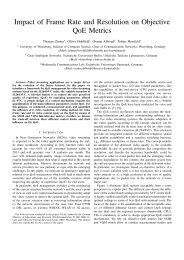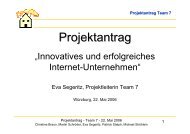Measurement and Analysis of Skype VoIP Traffic in 3G UMTS Systems
Measurement and Analysis of Skype VoIP Traffic in 3G UMTS Systems
Measurement and Analysis of Skype VoIP Traffic in 3G UMTS Systems
Create successful ePaper yourself
Turn your PDF publications into a flip-book with our unique Google optimized e-Paper software.
University <strong>of</strong> WürzburgInstitute <strong>of</strong> Computer ScienceResearch Report Series<strong>Measurement</strong> <strong>and</strong> <strong>Analysis</strong> <strong>of</strong> <strong>Skype</strong><strong>VoIP</strong> <strong>Traffic</strong> <strong>in</strong> <strong>3G</strong> <strong>UMTS</strong> <strong>Systems</strong>Tobias Hoßfeld 1 , Andreas B<strong>in</strong>zenhöfer 1 , Markus Fiedler 2 ,Kurt Tutschku 1Report No. 377 December 20051 University <strong>of</strong> WürzburgDepartment <strong>of</strong> Computer ScienceAm Hubl<strong>and</strong>, D-97074 Würzburg, Germany{hossfeld,b<strong>in</strong>zenhoefer,tutschku}@<strong>in</strong>formatik.uni-wuerzburg.de2 Blek<strong>in</strong>ge Institute <strong>of</strong> Technology,Department <strong>of</strong> Telecommunication <strong>Systems</strong>.SE-371 79 Karlskrona, Sweden.markus.fiedler@bth.se
<strong>Measurement</strong> <strong>and</strong> <strong>Analysis</strong> <strong>of</strong> <strong>Skype</strong><strong>VoIP</strong> <strong>Traffic</strong> <strong>in</strong> <strong>3G</strong> <strong>UMTS</strong> <strong>Systems</strong>Tobias Hoßfeld, Andreas B<strong>in</strong>zenhöfer,Kurt TutschkuUniversity <strong>of</strong> WürzburgDepartment <strong>of</strong> Computer ScienceAm Hubl<strong>and</strong>, D-97074 Würzburg, Germany{hossfeld,b<strong>in</strong>zenhoefer,tutschku}@<strong>in</strong>formatik.uni-wuerzburg.deMarkus FiedlerBlek<strong>in</strong>ge Institute <strong>of</strong> Technology,Department <strong>of</strong> Telecommunication <strong>Systems</strong>.SE-371 79 Karlskrona, Sweden.markus.fiedler@bth.seAbstract: Voice-over-IP (<strong>VoIP</strong>) telephony becomes more <strong>and</strong> more popular <strong>in</strong> the wired Internet because<strong>of</strong> easy-to-use applications with high sound quality like <strong>Skype</strong>. <strong>UMTS</strong> operators promise to <strong>of</strong>fer largedata rates which should also make <strong>VoIP</strong> possible <strong>in</strong> a mobile environment. However, the success <strong>of</strong> thoseapplication strongly depends on the user perceived voice quality. In this paper, we therefore analyze theachievable <strong>and</strong> the actual quality <strong>of</strong> IP-based telephony calls us<strong>in</strong>g <strong>Skype</strong>. This is done perform<strong>in</strong>g measurements<strong>in</strong> both a real <strong>UMTS</strong> network <strong>and</strong> a test environment. The latter is used to emulate rate controlmechanisms <strong>and</strong> chang<strong>in</strong>g system conditions <strong>of</strong> <strong>UMTS</strong> networks. The results show whether <strong>Skype</strong> over<strong>UMTS</strong> is able to keep pace with exist<strong>in</strong>g mobile telephony systems <strong>and</strong> how it reacts to different networkcharacteristics. The <strong>in</strong>vestigated performance measures comprise the Perceptual Evaluation <strong>of</strong> SpeechQuality (PESQ) to evaluate the voice quality, the packet loss, the <strong>in</strong>ter-packet delay, <strong>and</strong> the throughputto capture network-based factors. In this context, the concept <strong>of</strong> the Network Utility Function (NUF) isapplied to describe the impact <strong>of</strong> the network on the voice quality as perceived by the end-user.Keywords: <strong>VoIP</strong>, <strong>Skype</strong>, <strong>UMTS</strong>, measurement, Network Utility Function1 IntroductionVoice-over-IP (<strong>VoIP</strong>) telephony becomes more <strong>and</strong> more popular <strong>in</strong> the wired Internet because<strong>of</strong> easy-to-use applications with high sound quality like <strong>Skype</strong> [1, 2]. In conjunction with highspeed access technologies, like Digital Subscriber L<strong>in</strong>e (DSL), <strong>and</strong> flat-rate tariff models, <strong>VoIP</strong>telephony has grown to a strong competitor to the exist<strong>in</strong>g Public Switched Telephone Network(PSTN). <strong>UMTS</strong> operators, however, are still search<strong>in</strong>g for new applications which both exploitthe potential <strong>of</strong> the <strong>UMTS</strong> <strong>3G</strong> technology <strong>and</strong> motivate the user to adopt the technology. <strong>VoIP</strong>applications like the Peer-to-Peer (P2P) based <strong>Skype</strong> system might be an <strong>in</strong>terest<strong>in</strong>g c<strong>and</strong>idatefor such an application.Due to its P2P technology, <strong>Skype</strong> might <strong>of</strong>fer rapid access to a large base <strong>of</strong> users, seamlessservice operation across different types <strong>of</strong> networks (wirel<strong>in</strong>e <strong>and</strong> <strong>and</strong> wireless) <strong>and</strong> a serverless<strong>and</strong> cost efficient operation <strong>of</strong> a new service. As a result, a German <strong>UMTS</strong> operator has recentlyannounced the <strong>of</strong>ficial support <strong>of</strong> <strong>Skype</strong> <strong>in</strong> its system [3].<strong>UMTS</strong> operators promise to <strong>of</strong>fer large data rates which should make mobile <strong>VoIP</strong> possible.In the context <strong>of</strong> mobile communication systems, however, the perceived voice quality has tobe evaluated for IP-based telephony. In this paper, the achievable <strong>and</strong> the actual quality <strong>of</strong>1
voice calls us<strong>in</strong>g <strong>Skype</strong> is analyzed by perform<strong>in</strong>g measurements <strong>in</strong> a real <strong>UMTS</strong> network <strong>and</strong>additionally <strong>in</strong> a test environment. The testbed is used to emulate rate control mechanisms <strong>and</strong>chang<strong>in</strong>g radio propagation conditions <strong>in</strong> <strong>UMTS</strong>. The results show how <strong>Skype</strong> reacts to network<strong>in</strong>fluences <strong>and</strong> if <strong>Skype</strong> over <strong>UMTS</strong> keeps pace with exist<strong>in</strong>g mobile telephony systems. The<strong>in</strong>vestigated performance measures are the Perceptual Evaluation <strong>of</strong> Speech Quality (PESQ)for evaluat<strong>in</strong>g the voice quality, the packet loss, the <strong>in</strong>ter-packet delay, <strong>and</strong> the throughput fordescrib<strong>in</strong>g the network-based factors. The concept <strong>of</strong> the Network Utility Function (NUF) [4] isapplied to describe the impact <strong>of</strong> the network on the perceived voice quality.The rema<strong>in</strong>der <strong>of</strong> this work is organized as follows. In Section 2, the setups for the bottleneckLAN measurements <strong>and</strong> for the <strong>UMTS</strong> measurements are shown. Section 3 describes theperformance objectives <strong>and</strong> measures. The measurement results <strong>and</strong> the analysis <strong>of</strong> the <strong>Skype</strong>application <strong>in</strong> the different scenarios are given <strong>in</strong> Section 4. In particular, Section 4.1 coversthe bottleneck LAN which emulates chang<strong>in</strong>g wireless conditions by adapt<strong>in</strong>g the transmissionrate. The measurements <strong>in</strong> the real <strong>UMTS</strong> networks are evaluated <strong>in</strong> Section 4.2. In Section 4.3,we apply the network utility function which uses network-based parameters, like packet loss ordelay, as <strong>in</strong>put <strong>in</strong> order to derive the user perceived quality. F<strong>in</strong>ally, Section 5 concludes thiswork <strong>and</strong> gives an outlook for the next steps <strong>of</strong> the performance evaluation <strong>of</strong> <strong>Skype</strong>.2 <strong>Measurement</strong> Setup <strong>and</strong> ScenarioThe general measurement setup is the follow<strong>in</strong>g: <strong>Skype</strong> user A sends audio data to <strong>Skype</strong> userB. We used an English spoken text without noise, a sample rate <strong>of</strong> 8 kHz, encoded with 16 bitsper sample which is a st<strong>and</strong>ard audio file for evaluat<strong>in</strong>g <strong>VoIP</strong> <strong>and</strong> available at [5]. The wav-file isplayed with the W<strong>in</strong>amp audio player on mach<strong>in</strong>e A. The output <strong>of</strong> W<strong>in</strong>amp is used as <strong>in</strong>put for<strong>Skype</strong> (<strong>in</strong>stead <strong>of</strong> a microphone). On sender A <strong>and</strong> receiver B, W<strong>in</strong>dows XP is the OS, <strong>Skype</strong>v1.20.37 is <strong>in</strong>stalled <strong>and</strong> a packet trace is captured with TCPDump on each mach<strong>in</strong>e. In order tosave the received audio data, the output <strong>of</strong> <strong>Skype</strong> has to be forwarded with an audio cable fromB to another mach<strong>in</strong>e.2.1 Bottleneck LAN SetupIn a <strong>UMTS</strong> system, the conditions <strong>of</strong> the wireless channel are chang<strong>in</strong>g over time because <strong>of</strong>radio propagation effects or (slow <strong>and</strong> fast) fad<strong>in</strong>g, especially for a mov<strong>in</strong>g <strong>UMTS</strong> user. Additionally,the system load affects the available b<strong>and</strong>width <strong>of</strong> an arbitrary user. On rate-controlleddedicated channels or us<strong>in</strong>g HSUPA/HSDPA, this results <strong>in</strong> the b<strong>and</strong>with adaptation <strong>of</strong> a <strong>UMTS</strong>subscriber. In the bottleneck LAN scenario, we emulate a <strong>UMTS</strong> user who starts a <strong>Skype</strong> <strong>VoIP</strong>call <strong>and</strong> has an <strong>in</strong>itially assigned b<strong>and</strong>width <strong>of</strong> 16 kbps. Dur<strong>in</strong>g the call, the network conditionschange <strong>and</strong> the user is assigned a higher b<strong>and</strong>width. We <strong>in</strong>creased the b<strong>and</strong>width up to 384 kbpswhich reflects the currently <strong>of</strong>fered downl<strong>in</strong>k b<strong>and</strong>width <strong>of</strong> the public <strong>UMTS</strong> operator. In orderto evaluate <strong>and</strong> compare the perceived voice quality for the different assigned b<strong>and</strong>widths, thesame audio data was transmitted for each measured b<strong>and</strong>width. The b<strong>and</strong>width restriction wasrealized by us<strong>in</strong>g a traffic shap<strong>in</strong>g router, cf. Figure 1.2
• Cisco 2611 dual Ethernet router• Cisco 2611 dual Ethernet router• shapes outgo<strong>in</strong>g traffic for both <strong>in</strong>terfaces• shapes outgo<strong>in</strong>g traffic for both <strong>in</strong>terfaces• gateway for signal<strong>in</strong>g traffic to the Internet• gateway for signal<strong>in</strong>g traffic to the InternetInternet• <strong>Skype</strong> user A• <strong>Skype</strong> user A• sends audio data to B• sends audio data to B• packet trace (TCPDump)• packet trace (TCPDump)• <strong>Skype</strong> user B• <strong>Skype</strong> user B• receives audio data• receives audio data• packet trace (TCPDump)• packet trace (TCPDump)audio cable forsound forward<strong>in</strong>g• records audio data <strong>in</strong>to wav-file• records audio data <strong>in</strong>to wav-fileFigure 1: Bottleneck LAN scenario us<strong>in</strong>g a traffic shap<strong>in</strong>g routerAnother possibility to restrict the b<strong>and</strong>width <strong>in</strong> the LAN is us<strong>in</strong>g the dummynet s<strong>of</strong>tware [7]by sett<strong>in</strong>g an appropriate packet loss value, cf. Figure 2. In the dummynet scenario, <strong>Skype</strong>detects that packet loss occurs <strong>and</strong> <strong>in</strong>terpretes this as congestion <strong>in</strong> the network. Therefore,<strong>Skype</strong> tries to push away TCP traffic by <strong>in</strong>creas<strong>in</strong>g the throughput <strong>of</strong> the sender. The throughput<strong>in</strong>crease is realized by transmitt<strong>in</strong>g packets with the same frequency, but more payload. Figure 3shows the througput <strong>of</strong> the sender <strong>and</strong> the throughput at the receiver. As soon as <strong>Skype</strong> detectspacket loss it reacts by <strong>in</strong>creas<strong>in</strong>g the sender throughput from 24 kbps to roughly 39 kbps.The bottleneck LAN scenario us<strong>in</strong>g a traffic shap<strong>in</strong>g router <strong>and</strong> us<strong>in</strong>g the dummynet s<strong>of</strong>twareboth lead to the same received throughput <strong>and</strong> the same packet loss, <strong>Skype</strong> reacts differently<strong>in</strong> both scenarios. While <strong>in</strong> the dummynet scenario the sender’s througput is <strong>in</strong>creased, <strong>in</strong> thetraffic shap<strong>in</strong>g router scenario the sender sends constantly with roughly 24 kbps (which willbe discussed later <strong>in</strong> Section 4.1. The reason for this behaviour is the way how packet lossoccurs <strong>in</strong> both scenarios. Therefore, we consider the <strong>in</strong>ter packet loss distance. The distanceL between two consecutive packet losses is referred to as <strong>in</strong>ter packet loss distance. In the••DummynetDummynet••emulatesemulates<strong>in</strong>terfaces<strong>in</strong>terfacestotothethetwotwosubnetssubnetsSS A A <strong>and</strong><strong>and</strong>SS B B••performsperformsdelaydelay<strong>and</strong><strong>and</strong>packetpacketlosslossonon<strong>in</strong>terfaces<strong>in</strong>terfaces••gatewaygatewaytotothetheInternetInternetInternet••<strong>Skype</strong><strong>Skype</strong>useruserAA<strong>in</strong><strong>in</strong>subnetsubnetSS A A••IP:IP:192.168.1.10192.168.1.10• <strong>Skype</strong> user B• <strong>Skype</strong> user B<strong>in</strong> subnet S<strong>in</strong> subnet S B B• IP: 192.168.0.12• IP: 192.168.0.12audio cable forsound forward<strong>in</strong>g• records audio data <strong>in</strong>to wav-file• records audio data <strong>in</strong>to wav-fileFigure 2: Bottleneck LAN scenario us<strong>in</strong>g dummynet s<strong>of</strong>tware3
throughput [kbps]403530252015p loss= 10%10p loss= 50%5senderp loss= 70%receiver00 100 200 300 400 500time [s]Figure 3: Us<strong>in</strong>g dummynet, <strong>Skype</strong> reacts on packet loss by <strong>in</strong>creas<strong>in</strong>g the sender throughputdummynet scenario, the r<strong>and</strong>om variable L dummy follows a geometric distribution shifted byone: L dummy ∼ GEOM 1 (q) with parameter q = µ−1µ<strong>and</strong> a mean measured distance µ. Thenumber <strong>of</strong> consecutive packets without any packet loss is denoted as K. It holds: K = L − 1.Figure 4 compares the <strong>in</strong>ter packet loss distance for the dummynet <strong>and</strong> the traffic shap<strong>in</strong>grouter scenario. In the dummynet scenario, the packet loss probability was set to 50 percent. Inthe traffic shap<strong>in</strong>g router scenario, the b<strong>and</strong>width on the l<strong>in</strong>k was restricted to 16 kbps whichresults <strong>in</strong> a packet loss ratio <strong>of</strong> 48 percent. The dummynet s<strong>of</strong>tware leads to a geometric distributionwith q = 0.5 <strong>in</strong> Figure 4(a). This means each packet gets lost with propability q. Thetraffic shap<strong>in</strong>g router, however, leads to a completely different behaviour. Packets do not get lost<strong>in</strong>dependent <strong>of</strong> each other, but <strong>in</strong> bursts, which can be seen from Figure 4(b). Due to the nature0.70.60.5measuredGEOM 1(q)10.8measuredprobability0.40.3probability0.60.40.20.10.200 5 10<strong>in</strong>ter packet loss distance(a) Dummynet01 2 3 4 5 6 7 8 9 10 11 12<strong>in</strong>ter packet loss distance(b) <strong>Traffic</strong> shap<strong>in</strong>g routerFigure 4: Distance between two consecutive packet losses4
<strong>of</strong> wireless channels <strong>and</strong> <strong>in</strong> overload situations <strong>in</strong> a system, error bursts might better model thepacket loss behavior <strong>of</strong> <strong>Skype</strong> <strong>in</strong> <strong>3G</strong> networks. Therefore, <strong>in</strong> Section 4.1 we only consider thebottleneck LAN scenario us<strong>in</strong>g the traffic shap<strong>in</strong>g router.2.2 <strong>UMTS</strong> SetupIn the <strong>UMTS</strong> scenario, one <strong>Skype</strong> user is connected to the Internet us<strong>in</strong>g a public <strong>UMTS</strong> operator.We used a Vodafone Mobile Connect <strong>UMTS</strong> PC-card as modem for the mach<strong>in</strong>e. Currently,only dedidacted channels with fixed b<strong>and</strong>widths are used. While the upl<strong>in</strong>k capacity is limitedto 64 kbps, <strong>in</strong> the downl<strong>in</strong>k direction a b<strong>and</strong>width <strong>of</strong> 384 kbps is available. The other <strong>Skype</strong> useris connected via DSL <strong>and</strong> has capacity <strong>of</strong> 128 kbps <strong>in</strong> the upl<strong>in</strong>k <strong>and</strong> 1024 kbps <strong>in</strong> the downl<strong>in</strong>k.We <strong>in</strong>vestigated the upl<strong>in</strong>k scenario <strong>in</strong> which the <strong>UMTS</strong> subscriber sends the audio data with64 kbps to the DSL user. In the downl<strong>in</strong>k scenario the DSL user sends its data over the 128 kbpsl<strong>in</strong>k to the <strong>UMTS</strong> user.••<strong>Skype</strong><strong>Skype</strong>useruserAAviavia<strong>UMTS</strong><strong>UMTS</strong>• sends/receives audio data• sends/receives audio data• packet trace (TCPDump)• packet trace (TCPDump)••upl<strong>in</strong>k:upl<strong>in</strong>k:6464kbit/skbit/s••downl<strong>in</strong>k:downl<strong>in</strong>k:384384kbit/skbit/s<strong>UMTS</strong> <strong>UMTS</strong> Access AccessNetworkInternet••upl<strong>in</strong>k:upl<strong>in</strong>k:128128kbit/skbit/s••downl<strong>in</strong>k:downl<strong>in</strong>k:10241024kbit/skbit/s••<strong>Skype</strong><strong>Skype</strong>useruserBBviaviaDSLDSL••receives/sendsreceives/sendsaudioaudiodatadata••packetpackettracetrace(TCPDump)(TCPDump)DSL DSL Access AccessNetworkFigure 5: <strong>Measurement</strong> setup for <strong>UMTS</strong> scenario3 Performance ObjectivesThe performance objective <strong>of</strong> the measurements is the evaluation <strong>of</strong> the perceived voice quality.The International Telecommunication Union (ITU) recommends the Perceptual Evaluation <strong>of</strong>Speech Quality (PESQ) method described <strong>in</strong> ITU-T P.862. PESQ was specifically developed tobe applicable to end-to-end voice quality test<strong>in</strong>g under real network conditions, like <strong>VoIP</strong>, POTS,ISDN, GSM etc. PESQ requires the sent audio wav-file <strong>and</strong> the received wav-file as <strong>in</strong>put <strong>and</strong>returns as result a value between -0.5 (worst) <strong>and</strong> 4.5 (best), though <strong>in</strong> most cases it is between 1<strong>and</strong> 4.5. However the PESQ score tends to be optimistic for poor quality speech <strong>and</strong> pessimisticfor good quality speech. The degradation <strong>of</strong> the voice quality because <strong>of</strong> the <strong>Skype</strong> iLBC codec(with 30ms frames) <strong>and</strong> the measurement setup for sav<strong>in</strong>g the received audio data is illustrated <strong>in</strong>Figure 6. Hence, the PESQ value <strong>of</strong> 3.93 has to be used as reference value for the measurementsresults <strong>in</strong> Section 4.5
orig<strong>in</strong>al4.50wav-fileencodedecodesound has to be forwarded toanother mach<strong>in</strong>e <strong>in</strong> order tosave it to a wav-file on diskdegeneratedwav-file 4.02audio cablereceivedwav-file 3.93Figure 6: Reference PESQ value without <strong>in</strong>fluence <strong>of</strong> networkThe network-based factors which <strong>in</strong>fluence the perceived voice quality are the received throughput,the packet loss, the delay, <strong>and</strong> the delay jitter. The throughput <strong>in</strong>cludes the payload as wellas the UDP <strong>and</strong> IP headers. The headers <strong>of</strong> the data l<strong>in</strong>k layer <strong>and</strong> the physical layer are neglected<strong>in</strong> order to compare the throughputs <strong>in</strong> the bottleneck LAN scenario <strong>and</strong> <strong>in</strong> the <strong>UMTS</strong>scenario. The jitter is described by the packet <strong>in</strong>terarrival time (PIT), i.e. the time differencebetween two consecutive packet arrivals.While it is a trivial task to measure the network-based factors by captur<strong>in</strong>g a packet traceat the receiver, the factors have to be mapped to a value describ<strong>in</strong>g the <strong>in</strong>fluence <strong>of</strong> the networkon the speech quality. The PESQ reduction imposed by the network connectivity betweensender <strong>and</strong> receiver is described by the Network Utility Function (NUF) U Netw <strong>in</strong>troduced <strong>in</strong> [4]:PESQ rcvd ≃ U Netw · PESQ sent . In general, the NUF consists <strong>of</strong> a number <strong>of</strong> factors, eachreflect<strong>in</strong>g an impairment on the quality, U Netw = ∏ i U i U ∈ {0, 1} . In [4] the latter is concretisedas U Netw = U m · U s . The factor U m is called m-Utility Function (m-UF) <strong>and</strong> captureschanges <strong>of</strong> the mean throughput dur<strong>in</strong>g an observation w<strong>in</strong>dow <strong>of</strong> duration ∆W{from m sent } atthe sender to m rcvd at the receiver, which is reflected by the loss ratio l = max 1 − m rcvdm sent, 0 .The factor U s is denoted as s-Utility Function (s-UF) <strong>and</strong> captures changes <strong>of</strong> the st<strong>and</strong>ard deviation<strong>of</strong> the throughput from s sent to s rcvd also dur<strong>in</strong>g an observation w<strong>in</strong>dow ∆W . Thethroughput values used for calculat<strong>in</strong>g the st<strong>and</strong>ard deviation are averages dur<strong>in</strong>g short <strong>in</strong>tervals<strong>of</strong> duration ∆T . The relative change <strong>of</strong> the st<strong>and</strong>ard deviation is denoted by σ = s rcvds sent− 1 . Theconcrete application <strong>of</strong> the NUF concept will be discussed <strong>in</strong> Section 4.3.4 <strong>Measurement</strong>s <strong>and</strong> Results<strong>Skype</strong> uses different codecs to ma<strong>in</strong>ta<strong>in</strong> reasonable call qualities at an available b<strong>and</strong>width <strong>of</strong>at least 32 kbps [2]. In our measurements, we only observed the use <strong>of</strong> the iLBC codec [6]<strong>in</strong>dicated <strong>in</strong> the technical <strong>in</strong>formation field <strong>of</strong> the <strong>Skype</strong> application.4.1 Bottleneck LAN for Emulat<strong>in</strong>g Various Wireless Channel ConditionsIn this section we concentrate on the bottleneck LAN scenario, which is used to emulate thedynamically chang<strong>in</strong>g conditions <strong>of</strong> a <strong>UMTS</strong> system. We started with a l<strong>in</strong>k b<strong>and</strong>width <strong>of</strong> 16kbps <strong>and</strong> <strong>in</strong>creased the available b<strong>and</strong>width dur<strong>in</strong>g the <strong>Skype</strong> call to 32 kbps, 64 kbps, 128 kbps<strong>and</strong> 384 kbps respectively. Dur<strong>in</strong>g the tests, we observed that the measured PESQ values are6
very sensitive to small changes <strong>in</strong> the range between 16 <strong>and</strong> 64 kbps. Therefore, we additionallymeasured b<strong>and</strong>width restrictions to 24 kbps, 28 kbps, 40 kbps, 48 kbps <strong>and</strong> 56 kbps.The results are summarized <strong>in</strong> Figure 7, which plots the available b<strong>and</strong>width aga<strong>in</strong>st theachieved throughput <strong>of</strong> the <strong>VoIP</strong> call. Note, that the throughput <strong>in</strong>cludes the payload (67 Bytes)as well as the UDP <strong>and</strong> IP headers (28 Bytes). Each scenario was repeated between five <strong>and</strong> tentimes <strong>in</strong> order to produce credible emulation results. The figure shows the mean values <strong>of</strong> thedifferent emulation runs as well as the correspond<strong>in</strong>g m<strong>in</strong>imum <strong>and</strong> maximum. The first <strong>in</strong>terest<strong>in</strong>gobservation is that the send<strong>in</strong>g rate is not adapted to the available b<strong>and</strong>width or the packetloss respectively. The sender constantly uses a b<strong>and</strong>width close to 26 kbps. The communicationpartner receives a throughput, which corresponds to the currently available b<strong>and</strong>width on thel<strong>in</strong>k. That is, all rema<strong>in</strong><strong>in</strong>g packets are lost on the bottleneck l<strong>in</strong>k.If we use a s<strong>of</strong>tware tool, like dummynet [7] to generate packet loss, <strong>Skype</strong> <strong>in</strong>creases thesend<strong>in</strong>g rate to roughly 40 kbps <strong>in</strong> order to push away other traffic, assum<strong>in</strong>g packet loss tobe caused by congestion <strong>in</strong> the network. In the bottleneck scenario, <strong>Skype</strong> does not adapt itssend<strong>in</strong>g rate to the packet loss. The reason seems to be that packets are not lost r<strong>and</strong>omly (asgenerated by dummynet) but <strong>in</strong> bursts, what will be expla<strong>in</strong>ed later.263.50.5throughput [kbps]24222018161412m<strong>in</strong>/mean/maxthroughput <strong>of</strong> senderm<strong>in</strong>/mean/maxthroughput <strong>of</strong> receiver16 24 28 32 40 48 64 128256384b<strong>and</strong>width [kbps]PESQ32.521.51m<strong>in</strong>/mean/maxPESQ valuem<strong>in</strong>/mean/maxpacket loss ratio16 28 40 64 256b<strong>and</strong>width [kbps]0.40.30.20.10packet loss ratioFigure 7: Throughput <strong>of</strong> sender <strong>and</strong> receiverFigure 8: PESQ <strong>and</strong> packet loss probabilityBefore that, we have a closer look at the PESQ value <strong>in</strong> this scenario as illustrated <strong>in</strong> Figure 8.The figure shows the achieved PESQ value for different l<strong>in</strong>k speeds between 16 <strong>and</strong> 384 kbps <strong>and</strong>relates them to the observed packet loss. Obviously, the higher the packet loss, the lower is thecorrespond<strong>in</strong>g PESQ value. There is no more packet loss above a l<strong>in</strong>k speed <strong>of</strong> 29 kbps s<strong>in</strong>ceup from this po<strong>in</strong>t the throughput <strong>of</strong> the sender (109Byte/30ms) is smaller than the availableb<strong>and</strong>width on the l<strong>in</strong>k. The correspond<strong>in</strong>g PESQ values oscillate around a value <strong>of</strong> 2.9. S<strong>in</strong>cethe PESQ value is a very sensitive performance measure, the fluctuations can be expla<strong>in</strong>ed bythe stochastic <strong>in</strong>fluences <strong>of</strong> the network, like jitter.In order to underst<strong>and</strong> the details <strong>of</strong> the bottleneck <strong>in</strong> this scenario, we focus on a s<strong>in</strong>gleemulation run. Figure 9 shows the CDF <strong>of</strong> the packet <strong>in</strong>terarrival time for both the sender <strong>and</strong>the receiver <strong>of</strong> the <strong>VoIP</strong> call, us<strong>in</strong>g a bottleneck speed <strong>of</strong> 16 kbps. The sudden jump from 0to 1 at the CDF <strong>of</strong> the sender illustrates an almost constant time <strong>of</strong> 30ms between two sent7
1CDF0.80.60.40.2<strong>in</strong>terarrival times<strong>of</strong> sent packets<strong>in</strong>terarrival times<strong>of</strong> received packetspayload observed <strong>in</strong>terarrival[Byte] packets timesender 3 3 20.05 ssender 67 1888 30.00 msrcver 3 3 20.25 srcver 67 1039 54.43 ms00 200 400 600packet <strong>in</strong>terarrival time [ms]Figure 9: S<strong>in</strong>gle run with 16 kbps bottleneck <strong>and</strong> 8000 bit buffer <strong>in</strong> the routerpackets. At first glance, the CDF <strong>of</strong> the receiver has a very unexpected shape. About 90 percent<strong>of</strong> all packets have an <strong>in</strong>terarrival time <strong>of</strong> practically 0ms, while the time between the rema<strong>in</strong><strong>in</strong>gpackets is about 500ms. The buffer <strong>in</strong> the router was set to 8000 Bit, while simultaneouslylimit<strong>in</strong>g the speed <strong>of</strong> the l<strong>in</strong>k to 16 kbps. <strong>Skype</strong> used a total packet size <strong>of</strong> 872 Bit. Thus, atmost 9 packets (872*9= 7848 Bit) fit <strong>in</strong>to the buffer <strong>of</strong> the router. To emulate a l<strong>in</strong>k speed <strong>of</strong>16 kbps, the router fills its buffer <strong>and</strong> delays the data for exactly 500ms. This way, a b<strong>and</strong>width<strong>of</strong> 8000 Bits/500ms = 16 kbps is achieved on a physical 100Mbit/s l<strong>in</strong>k. This has two majorimplications. At first the <strong>in</strong>terarrival time <strong>of</strong> the packets with<strong>in</strong> a burst is 872 Bit/100 Mbit/s,which is <strong>in</strong> the range <strong>of</strong> 10 −6 s ≈ 0 ms <strong>and</strong> expla<strong>in</strong>s the shape <strong>of</strong> the CDF <strong>in</strong> Figure 9. Secondly,packet loss occurs <strong>in</strong> bursts dur<strong>in</strong>g the 500ms, <strong>in</strong> which the buffer <strong>of</strong> the router is delayed.F<strong>in</strong>ally, the table <strong>in</strong> Figure 9 shows the payload size <strong>and</strong> the observed number <strong>of</strong> packets <strong>of</strong>this size for both the sender <strong>and</strong> the receiver, as well as the correspond<strong>in</strong>g <strong>in</strong>terrarival times. Thepackets with a payload <strong>of</strong> 67 Bytes represent the voice connection. Only 1039 <strong>of</strong> the 1888 sentpackets arrive at the receiver, which corresponds to a packet loss <strong>of</strong> about 45 percent <strong>and</strong> expla<strong>in</strong>sthe <strong>in</strong>crease <strong>in</strong> the average <strong>in</strong>terarrival time from 30ms to 54.43ms. An <strong>in</strong>terest<strong>in</strong>g observation isthat <strong>Skype</strong> obviously sends some smaller packets (3 Bytes) every 20 seconds, which we believeto be quality feedback. This would also expla<strong>in</strong> how a <strong>Skype</strong> client is able to display the packetloss <strong>of</strong> the remote side <strong>in</strong> its technical <strong>in</strong>fo w<strong>in</strong>dow dur<strong>in</strong>g an active call.4.2 <strong>Measurement</strong>s <strong>in</strong> <strong>UMTS</strong> NetworkAll experiments <strong>in</strong> this section were done us<strong>in</strong>g our <strong>UMTS</strong> setup as described <strong>in</strong> Section 2.2.Dur<strong>in</strong>g all measurements the clients used a different codec for the ma<strong>in</strong> audio connection, send<strong>in</strong>g108 Byte <strong>of</strong> payload every 60ms <strong>in</strong>stead <strong>of</strong> 67 Byte every 30ms like <strong>in</strong> the previous scenarios.S<strong>in</strong>ce this codec was used start<strong>in</strong>g with the first audio packet, <strong>Skype</strong> seems to choose this codecbased on local <strong>in</strong>formation, like access type (modem or LAN) to the Internet, or due to exchangedpackets before measur<strong>in</strong>g the l<strong>in</strong>k quality. This assumption is supported by the fact,that emulat<strong>in</strong>g the l<strong>in</strong>k properties (delay, b<strong>and</strong>width) with dummynet did not cause <strong>Skype</strong> to usethe same codec. There was nearly no packet loss <strong>in</strong> any <strong>of</strong> the experiments. In total, 11 out <strong>of</strong>8
15417 packets were lost <strong>in</strong> the <strong>UMTS</strong> measurements. However, the PESQ values are lower thanbefore because <strong>of</strong> the network jitter. In the follow<strong>in</strong>g we concentrate on the packet <strong>in</strong>terarrivaltimes (PIT).4.2.1 Upl<strong>in</strong>k: <strong>UMTS</strong> subscriber sends to wirel<strong>in</strong>e userIn this upl<strong>in</strong>k scenario the <strong>UMTS</strong> client uses a 64 kbps connection to send its data to the DSLuser, which has a maximum download capacity <strong>of</strong> 1024 kbps.Figure 10(a) shows the CDF <strong>of</strong> the packet <strong>in</strong>terarrival time (PIT) for both the sender <strong>and</strong>the receiver. The <strong>UMTS</strong> client constantly sends a voice packet every 60 ms. However, due tothe jitter <strong>in</strong> the network the PITs at the receiver side are spread around the mean. The almostsymmetric shape <strong>of</strong> the CDF reflects the fact that for every delayed packet there is obviously apacket with a correspond<strong>in</strong>gly smaller PIT.CDF10.80.60.40.2DSL receiverwith 1024 kbps<strong>UMTS</strong> senderwith 64 kbps00 100 200 300 400packet <strong>in</strong>terarrival time [ms](a) Cumulative distribution functionpackets (sorted by arrival times)1000800600400200<strong>UMTS</strong> sender with 64 kbpsDSL receiver with 1024 kbps040 50 60 70packet <strong>in</strong>terarrival time [ms](b) Trace <strong>of</strong> packet arrivalsFigure 10: Packet <strong>in</strong>terarrival times <strong>in</strong> the <strong>UMTS</strong> upl<strong>in</strong>k scenarioTo illustrate this effect, Figure 10(b) plots the PIT for each packet at the sender <strong>and</strong> the receiver.There were 878 packets <strong>in</strong> this scenario. The x-axis shows the PIT, the y-axis plots thepacket <strong>of</strong> the correspond<strong>in</strong>g number as sorted by their arrival time. That is, the plot shows howmany packets arrived with a specific PIT. As expected, the packets <strong>of</strong> the DSL user are r<strong>and</strong>omlydistributed due to the jitter <strong>in</strong> the network. The <strong>UMTS</strong> packets, however, are sent at a discreteresolution <strong>of</strong> 1ms as can be seen by the vertical l<strong>in</strong>es <strong>in</strong> the figure. Note that this discretizationalready happens at the sender <strong>and</strong> is thus locally <strong>in</strong>fluenced, probably by the PCMCIA <strong>UMTS</strong>card. We are therefore able to exclude buffer effects <strong>and</strong> the like <strong>in</strong> the core network for thesame discretization <strong>in</strong> the downl<strong>in</strong>k scenario.Table 1 presents a more detailed view on some key performance measures for the upl<strong>in</strong>kscenario us<strong>in</strong>g a ∆T <strong>of</strong> 300ms. In particular, it shows the average throughput (m sent , m rcvd )<strong>and</strong> the average deviation (s sent , s rcvd ) for ten different runs <strong>of</strong> the experiment as well as thecorrespond<strong>in</strong>g st<strong>and</strong>ard deviation for each measure. S<strong>in</strong>ce there is almost no packet loss <strong>in</strong>this scenario, the throughput <strong>of</strong> the receiver corresponds to the throughput <strong>of</strong> the sender. The9
Table 1: Key performance measures for <strong>UMTS</strong> upl<strong>in</strong>k scenariothroughput deviation goodput deviation PESQm sent s sent m rcvd s rcvd Q[bps] [bps] [bps] [bps]µ 18071.58 2300.95 18055.23 3497.57 2.24σ 8.84 568.87 21.20 858.38 0.16Table 2: Received packets <strong>in</strong> the <strong>UMTS</strong> upl<strong>in</strong>k scenariopayload number mean PIT std. PIT3 Byte 3 20.02 s 10.73 ms108 Byte 847 61.97 ms 35.00 ms112 Byte 28 1.92 s 27.05 mscorrespond<strong>in</strong>g st<strong>and</strong>ard deviation (8.84 bps) <strong>of</strong> the <strong>in</strong>dividual runs is close to zero, as the samecodec with a fixed payload size <strong>and</strong> PIT was used <strong>in</strong> each <strong>of</strong> the ten experiments. However,s sent <strong>and</strong> s rcvd differ by about 1200 bps <strong>in</strong> the upl<strong>in</strong>k. Due to the jitter <strong>in</strong> the network theobserved PITs are almost uniformly spread around the mean PIT, which is also reflected <strong>in</strong> thelower PESQ value (2.24) as compared to the bottleneck LAN scenario (2.95) with the b<strong>and</strong>widthrestriction to 64 kbps.To highlight these effects <strong>in</strong> more detail, Table 2 shows the packets received at the DSLclient dur<strong>in</strong>g a s<strong>in</strong>gle run <strong>of</strong> the experiment. As before, the 3 Byte packets are used for qualityfeedback. However, this specific <strong>Skype</strong> codec uses two types <strong>of</strong> packet (108 Byte <strong>and</strong> 112 Byte)<strong>in</strong> the ma<strong>in</strong> audio stream. Thereby every 32th packet is <strong>of</strong> size 112 Bytes, which expla<strong>in</strong>s whythe mean PIT <strong>of</strong> the 108 Byte packets is 61.97ms <strong>in</strong>stead <strong>of</strong> 60ms. The high st<strong>and</strong>ard deviation<strong>of</strong> the PIT <strong>of</strong> these packets confirms our previous statements. The same behavior was observed<strong>in</strong> all n<strong>in</strong>e rema<strong>in</strong><strong>in</strong>g experiment runs.4.2.2 Downl<strong>in</strong>k: Wirel<strong>in</strong>e user sends to <strong>UMTS</strong> subscriberIn this scenario we regard the opposite direction, where the DSL user sends its voice data overa 128 kbps l<strong>in</strong>k to the <strong>UMTS</strong> user, who has a downl<strong>in</strong>k capacity <strong>of</strong> 384kbps. Thereby the<strong>in</strong>terest<strong>in</strong>g effects occur on the l<strong>in</strong>k from the base station to the <strong>UMTS</strong> mobile.Figure 11(a) shows the CDF <strong>of</strong> the PIT at the DSL sender <strong>and</strong> the <strong>UMTS</strong> receiver. Likebefore, the packets are sent <strong>in</strong>to the network exactly every 60ms. The <strong>UMTS</strong> receiver, however,registers a different behavior <strong>of</strong> the <strong>in</strong>com<strong>in</strong>g packets. The PIT <strong>of</strong> the arriv<strong>in</strong>g packets is nolonger uniformly spread around the mean PIT, but ma<strong>in</strong>ly takes three discrete values, 40ms,60ms, <strong>and</strong> 80ms. The difference <strong>of</strong> these values, corresponds to a <strong>UMTS</strong> Transmission TimeInterval (TTI) value <strong>of</strong> 20ms. As can be seen by the CDF, about 60 percent <strong>of</strong> all packetsarrive with a PIT <strong>of</strong> 60ms at the <strong>UMTS</strong> receiver. Approximately every 5th packet misses thecorrespond<strong>in</strong>g TTI, cf. Figure 11(b), <strong>and</strong> subsequently arrives with a PIT <strong>of</strong> 80ms. Thereforethe next packet, which hits the correct TTI, has a PIT <strong>of</strong> 40ms <strong>in</strong>stead <strong>of</strong> 60ms. This means that20 percent <strong>of</strong> all packets have a PIT <strong>of</strong> 80ms <strong>and</strong> 40ms, respectively.10
CDF10.80.60.40.2<strong>UMTS</strong> receiverwith 384 kbpsDSL senderwith 128 kbps00 50 100 150packet <strong>in</strong>terarrival time [ms](a) Cumulative distribution functionpacket <strong>in</strong>terarrival time [ms]80706050403020<strong>UMTS</strong> receiver 384 kbps90 100 110 120 130 140packets (sorted by arrival times)(b) Trace <strong>of</strong> received packetsFigure 11: Interarrival times <strong>of</strong> received packets <strong>in</strong> the <strong>UMTS</strong> downl<strong>in</strong>k scenarioTable 3 gives a more detailed view <strong>of</strong> the key performance measures <strong>in</strong> the downl<strong>in</strong>k scenario.The mean throughput <strong>of</strong> the receiver aga<strong>in</strong> corresponds to the throughput <strong>of</strong> the sender. Thistime, s sent <strong>and</strong> s rcvd do not differ as much as <strong>in</strong> the upl<strong>in</strong>k scenario. Thus, the network shouldhave less <strong>in</strong>fluence on the user perceived quality <strong>of</strong> the audio connection. The PESQ is <strong>in</strong>deedhigher <strong>in</strong> the downl<strong>in</strong>k scenario (2.49) than before <strong>in</strong> the upl<strong>in</strong>k scenario (2.24). Note that thest<strong>and</strong>ard deviations <strong>in</strong> the last row <strong>of</strong> the table are slightly higher, s<strong>in</strong>ce the number <strong>of</strong> qualityfeedback packets varied <strong>in</strong> the different experiment runs.Table 4 summarizes the four different packet sizes at the <strong>UMTS</strong> receiver <strong>in</strong> this scenario.Aga<strong>in</strong> for the most part 108 Byte packets were used for the audio connection, while this timeonly every 54th packet had a payload <strong>of</strong> 112 Bytes. In exchange, there is a new packet typeus<strong>in</strong>g 21 Bytes. This k<strong>in</strong>d <strong>of</strong> packet was also used <strong>in</strong> the audio connection, replac<strong>in</strong>g some <strong>of</strong> the108 Byte packets. However, they were sent very irregularly as can be seen by the high st<strong>and</strong>arddeviation <strong>of</strong> their PIT. The same irregularity was obta<strong>in</strong>ed for the 3 Byte packets, which did nothave a determ<strong>in</strong>istic PIT <strong>of</strong> 20s but were sent every 10s on average with a st<strong>and</strong>ard deviation <strong>of</strong>4.49s. What exactly triggers <strong>Skype</strong> to use this specific variation <strong>of</strong> the codec is subject to furtherstudy.Table 3: Key performance measures for <strong>UMTS</strong> downl<strong>in</strong>k scenariothroughput deviation goodput deviation PESQm sent s sent m rcvd s rcvd Q[bps] [bps] [bps] [bps]µ 18023.77 1848.15 18007.08 2172.39 2.49σ 48.16 282.70 51.64 284.97 0.08511
Table 4: Received packets <strong>in</strong> <strong>UMTS</strong> downl<strong>in</strong>k scenariopayload number mean PIT std. PIT3 B 6 9.46 s 4.49 s21 B 14 1.73 s 3.58 s108 B 817 61.32 ms 16.00 ms112 B 16 3.20 s 45.02 ms4.3 Network Utility FunctionWe <strong>in</strong>vestigate the impact <strong>of</strong> the loss ratio on the NUF, i.e. on the PESQ, by study<strong>in</strong>g thebottleneck LAN scenario described <strong>in</strong> Section 4.1 <strong>and</strong> us<strong>in</strong>g ∆T = 150 ms. By reduc<strong>in</strong>g thespeed <strong>of</strong> the bottleneck l<strong>in</strong>k beyond the need <strong>of</strong> the <strong>Skype</strong> connection, we provoke loss whose<strong>in</strong>tensity is roughly given by the miss<strong>in</strong>g capacity share. Figure 12 shows a scatter plot <strong>of</strong> PESQversus the loss ratio l. Even though the PESQ values are highly vary<strong>in</strong>g even for similar lossratios, a l<strong>in</strong>ear trend can be observed <strong>in</strong> Figure 12 as l <strong>in</strong>creases (as assumed <strong>in</strong> [4]). Simpleregression analysis for l ≤ 0.2 (i.e. a l<strong>in</strong>k speed <strong>of</strong> at least 24 kbps) leads to U m ≃ 1 − 1.5 l.Interest<strong>in</strong>gly enough, the change <strong>in</strong> the relative st<strong>and</strong>ard deviation jumps from σ ≃ 0 to σ ≃ 0.3as soon as loss due to overload occurs, while the damp<strong>in</strong>g <strong>of</strong> the PESQ as a function <strong>of</strong> theoverload <strong>in</strong>tensity is sufficiently described by the m-utility function alone. This behavior isdifferent from the one observed <strong>in</strong> [4], where the sources <strong>of</strong> loss <strong>and</strong> delay variations were<strong>in</strong>dependent <strong>of</strong> each other. On the other h<strong>and</strong>, there is an impact on the PESQ which is due to thefact that a network is used, which is captured by the n-utility function U n = 2.90/3.93 ≃ 0.74(cf. Sect. 3). Thus, the complete NUF <strong>in</strong> the bottleneck LAN case reads U Netw ≃ U n · U m <strong>and</strong>U s = 1.In the <strong>UMTS</strong> scenario (cf. Section 4.2), no significant loss has been observed, which meansU m ≃ 1. However, as seen from the scatter plot shown <strong>in</strong> Figure 13, upl<strong>in</strong>k <strong>and</strong> downl<strong>in</strong>kPESQ3.532.516 kbps24 kbps28 kbps32 kbpsPESQ2.82.62.4upl<strong>in</strong>kdownl<strong>in</strong>k22.21.50 0.2 0.4packet loss ratio20 0.02 0.04 0.06 0.08 0.1σ = (s − s ) / s rcvd sent sentFigure 12: Packet loss probability l vs. PESQ forthe bottleneck LAN scenarioFigure 13: σ = (s rcvd − s sent ) /s sent vs. PESQfor the <strong>UMTS</strong> scenario12
experience different <strong>in</strong>tensities <strong>of</strong> throughput variations [8], which allows us to take approximateit as follows: U s ≃ 1 − 2σ (0 ≤ σ < 0.1). As discussed <strong>in</strong> Section 4.2, the orig<strong>in</strong> <strong>of</strong> the PESQvalues is not the same as <strong>in</strong> the bottleneck LAN case (2.49 for σ = 0 <strong>in</strong>stead <strong>of</strong> 2.90, cf. Fig. 13with 12). We can capture this effect, caused by the mobile network <strong>and</strong> <strong>Skype</strong>’s selection <strong>of</strong> anappropriate codec, by modify<strong>in</strong>g the value <strong>of</strong> the n-utility function to U n = 2.49/3.93 ≃ 0.63.Summariz<strong>in</strong>g, the NUF as a whole reads U Netw = U n · U m · U s .5 Conclusion <strong>and</strong> Outlook<strong>VoIP</strong> telephony has become a strong competitor to exist<strong>in</strong>g telephone networks. In this study,the user perceived quality <strong>of</strong> <strong>Skype</strong> calls over <strong>UMTS</strong> was measured <strong>and</strong> analyzed <strong>in</strong> terms <strong>of</strong>PESQ values <strong>and</strong> network-based <strong>in</strong>fluence factors, like packet loss, throughput, <strong>and</strong> jitter.We emulated the rate control mechanisms <strong>in</strong> <strong>UMTS</strong> by restrict<strong>in</strong>g the l<strong>in</strong>k b<strong>and</strong>width with atraffic-shap<strong>in</strong>g router. In this case, <strong>Skype</strong> does not react to packet loss, as e.g. by <strong>in</strong>creas<strong>in</strong>gthe sender throughput, but constantly sends audio data with roughly 25 kbps. The occurr<strong>in</strong>gpacket loss degrades the PESQ value. For bottleneck l<strong>in</strong>ks below 32 kbps, a l<strong>in</strong>ear dependency<strong>of</strong> the PESQ value on the loss was discovered, while it varies around 2.9 for l<strong>in</strong>ks <strong>of</strong> higherb<strong>and</strong>width. The measurements <strong>in</strong> a public <strong>UMTS</strong> networks revealed that the capacity <strong>of</strong>fered by<strong>UMTS</strong> is sufficient to make mobile <strong>VoIP</strong> calls possible. However, due to network jitter <strong>and</strong> theuse <strong>of</strong> a different codec by <strong>Skype</strong>, the PESQ values are worse than those <strong>in</strong> the emulation <strong>of</strong> thebottleneck <strong>in</strong> a LAN environment. The used <strong>UMTS</strong> card sends <strong>and</strong> receives packets at discretetime <strong>in</strong>stants <strong>in</strong> multiples <strong>of</strong> 1 ms. The packet <strong>in</strong>terarrival times on the downl<strong>in</strong>k are multiples<strong>of</strong> 20 ms, which corresponds to a common transport time <strong>in</strong>terval TTI <strong>in</strong> <strong>UMTS</strong>.F<strong>in</strong>ally, we showed that the concept <strong>of</strong> the Network Utility Function can be applied to describethe impact <strong>of</strong> the network on the PESQ. Thereby the network-based <strong>in</strong>fluence factors aresufficient to approximate the PESQ values. The next step will be to <strong>in</strong>vestigate the dependencybetween loss <strong>and</strong> chang<strong>in</strong>g traffic characteristics <strong>and</strong> the correspond<strong>in</strong>g impact on the PESQ <strong>and</strong>the utility functions.AcknowledgementsThe authors would like to thank Melanie Brotzeller for perform<strong>in</strong>g the measurements, programm<strong>in</strong>gall scripts, <strong>and</strong> the fruitful discussions; Thomas Z<strong>in</strong>ner, <strong>and</strong> Frank Bennewitz for help<strong>in</strong>gdur<strong>in</strong>g the measurements; Stefan Chevul for the much appreciated <strong>in</strong>put dur<strong>in</strong>g the course <strong>of</strong>this work; <strong>and</strong> Frank-Uwe Andersen <strong>and</strong> the Siemens AG for support<strong>in</strong>g the measurements.13
References[1] <strong>Skype</strong> Technologies S.A., http://www.skype.com/.[2] Baset, S., Schulzr<strong>in</strong>ne., H.: An analysis <strong>of</strong> the skype peer-to-peer <strong>in</strong>ternet telephony protocol.Technical Report CUCS-039-04, Columbia University, New York (2004)[3] <strong>Skype</strong> Technologies S.A.,http://www.skype.com/company/news/2005/skype_eplus.html.[4] Fiedler, M., Chevul, S., Radtke, O., Tutschku, K., B<strong>in</strong>zenhöfer, A.: The Network UtilityFunction: A practicable concept for assess<strong>in</strong>g network impact on distributed systems. In:19th International Teletraffic Congress (ITC19), Beij<strong>in</strong>g, Ch<strong>in</strong>a (2005) 1465–1474[5] Signalogic, Speech Codec Wav Samples, http://www.signalogic.com/<strong>in</strong>dex.pl?page=codec_samples.[6] Andersen, S., Duric, A., Astrom, H., Hagen, R., Kleijn, W., L<strong>in</strong>den, J.: RFC 3951: <strong>in</strong>ternetlow bit rate codec (ilbc) (2004)[7] Rizzo L., Dummynet, http://<strong>in</strong>fo.iet.unipi.it/˜luigi/ip_dummynet/.[8] Isaksson, L., Chevul, S., Fiedler, M., Karlsson, J., L<strong>in</strong>dberg, P.: Application perceivedthroughput process <strong>in</strong> wireless systems, ICMCS’05, Montreal, Canada (2005)14


